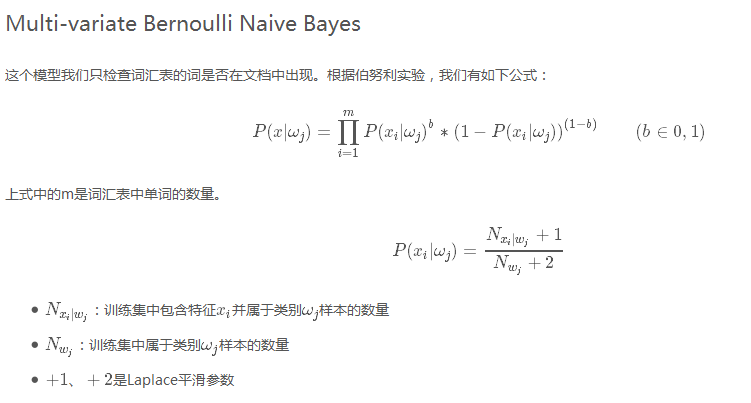Spark中组件Mllib的学习32之朴素贝叶斯分类器(伯努利朴素贝叶斯)*
更多代码请见:https://github.com/xubo245/SparkLearningSpark中组件Mllib的学习之分类篇1解释(1) 朴素贝叶斯分类器种类在把训练集中的每个文档向量化的过程中,存在两个模型。一个是统计词在文档中出现的次数(多项式模型);一个是统计词是否在文档中出现过(柏努利模型)目前mllib只支持多项式朴素贝叶斯和伯努利贝叶斯(spark-1.
·
更多代码请见:https://github.com/xubo245/SparkLearning
Spark中组件Mllib的学习之分类篇
1解释
(1) 朴素贝叶斯分类器种类
在把训练集中的每个文档向量化的过程中,存在两个模型。一个是统计词在文档中出现的次数(多项式模型);一个是统计词是否在文档中出现过(柏努利模型)
目前mllib只支持多项式朴素贝叶斯和伯努利贝叶斯(spark-1.5.2),不支持高斯朴素贝叶斯。
根据:
/**
* Trains a Naive Bayes model given an RDD of `(label, features)` pairs.
*
* This is the Multinomial NB ([[http://tinyurl.com/lsdw6p]]) which can handle all kinds of
* discrete data. For example, by converting documents into TF-IDF vectors, it can be used for
* document classification. By making every vector a 0-1 vector, it can also be used as
* Bernoulli NB ([[http://tinyurl.com/p7c96j6]]). The input feature values must be nonnegative.
*/
@Since("0.9.0")
class NaiveBayes private (
private var lambda: Double,
private var modelType: String) extends Serializable with Logging {
import NaiveBayes.{Bernoulli, Multinomial}
@Since("1.4.0")
def this(lambda: Double) = this(lambda, NaiveBayes.Multinomial)
三种朴素贝叶斯分类器都在【4】中有提到
(2)伯努利贝叶斯分类器

参考【5】
2.代码:
/**
* @author xubo
* ref:Spark MlLib机器学习实战
* more code:https://github.com/xubo245/SparkLearning
* more blog:http://blog.csdn.net/xubo245
*/
package org.apache.spark.mllib.learning.classification
import java.text.SimpleDateFormat
import java.util.Date
import org.apache.spark.mllib.classification.NaiveBayes._
import org.apache.spark.mllib.classification.{NaiveBayes, NaiveBayesModel}
import org.apache.spark.mllib.linalg.Vectors
import org.apache.spark.mllib.regression.LabeledPoint
import org.apache.spark.{SparkException, SparkConf, SparkContext}
/**
* Created by xubo on 2016/5/23.
* From:NaiveBayesSuite.scala in spark 1.5.2 sources
* another examples:NaiveBayesSuite test("Naive Bayes Bernoulli")
*/
object BernoulliNaiveBayesLearning {
def main(args: Array[String]) {
val conf = new SparkConf().setMaster("local[4]").setAppName(this.getClass().getSimpleName().filter(!_.equals('$')))
val sc = new SparkContext(conf)
val badTrain = Seq(
LabeledPoint(1.0, Vectors.dense(1.0)),
// LabeledPoint(0.0, Vectors.dense(2.0)),
LabeledPoint(1.0, Vectors.dense(1.0)),
LabeledPoint(1.0, Vectors.dense(0.0)))
val model1 = NaiveBayes.train(sc.makeRDD(badTrain, 2), 1.0, Bernoulli)
println("model1:")
println(model1)
sc.makeRDD(badTrain, 2).foreach(println)
val okTrain = Seq(
LabeledPoint(1.0, Vectors.dense(1.0)),
LabeledPoint(0.0, Vectors.dense(0.0)),
LabeledPoint(1.0, Vectors.dense(1.0)),
LabeledPoint(1.0, Vectors.dense(1.0)),
LabeledPoint(0.0, Vectors.dense(0.0)),
LabeledPoint(1.0, Vectors.dense(1.0)),
LabeledPoint(1.0, Vectors.dense(1.0))
)
val badPredict = Seq(
Vectors.dense(1.0),
// Vectors.dense(2.0),
Vectors.dense(1.0),
Vectors.dense(0.0))
val model = NaiveBayes.train(sc.makeRDD(okTrain, 2), 1.0, Bernoulli)
// intercept[SparkException] {
val pre2 = model.predict(sc.makeRDD(badPredict, 2)).collect()
// }
println("model2:")
sc.makeRDD(okTrain, 2).foreach(println)
println("predict data:")
sc.makeRDD(badPredict, 2).foreach(println)
println(model)
println("predict result:")
pre2.foreach(println)
sc.stop
}
}
3.结果:
model1:
org.apache.spark.mllib.classification.NaiveBayesModel@79d63340
(1.0,[1.0])
(1.0,[1.0])
(1.0,[0.0])
model2:
(1.0,[1.0])
(0.0,[0.0])
(1.0,[1.0])
(1.0,[1.0])
(0.0,[0.0])
(1.0,[1.0])
(1.0,[1.0])
predict data:
[1.0]
[0.0]
[1.0]
org.apache.spark.mllib.classification.NaiveBayesModel@3eda0bed
predict result:
1.0
1.0
0.0参考
【1】http://spark.apache.org/docs/1.5.2/mllib-guide.html
【2】http://spark.apache.org/docs/1.5.2/programming-guide.html
【3】https://github.com/xubo245/SparkLearning
【4】http://www.letiantian.me/2014-10-12-three-models-of-naive-nayes/
【5】http://blog.csdn.net/xlinsist/article/details/51264829
更多推荐
 已为社区贡献5条内容
已为社区贡献5条内容









所有评论(0)